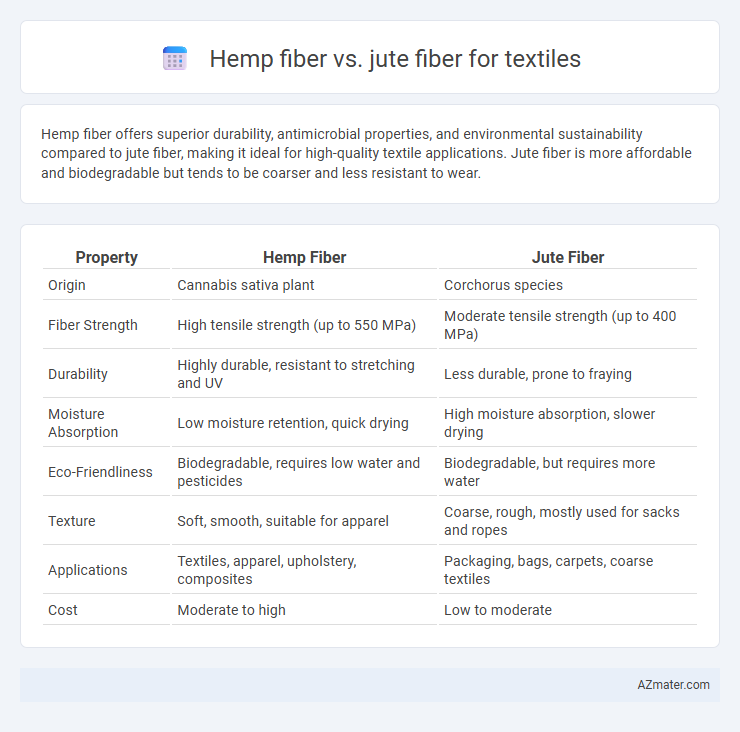Hemp fiber offers superior durability, antimicrobial properties, and environmental sustainability compared to jute fiber, making it ideal for high-quality textile applications. Jute fiber is more affordable and biodegradable but tends to be coarser and less resistant to wear.
Table of Comparison
| Property | Hemp Fiber | Jute Fiber |
|---|---|---|
| Origin | Cannabis sativa plant | Corchorus species |
| Fiber Strength | High tensile strength (up to 550 MPa) | Moderate tensile strength (up to 400 MPa) |
| Durability | Highly durable, resistant to stretching and UV | Less durable, prone to fraying |
| Moisture Absorption | Low moisture retention, quick drying | High moisture absorption, slower drying |
| Eco-Friendliness | Biodegradable, requires low water and pesticides | Biodegradable, but requires more water |
| Texture | Soft, smooth, suitable for apparel | Coarse, rough, mostly used for sacks and ropes |
| Applications | Textiles, apparel, upholstery, composites | Packaging, bags, carpets, coarse textiles |
| Cost | Moderate to high | Low to moderate |
Introduction to Hemp and Jute Fibers
Hemp fiber, derived from the stalks of the Cannabis sativa plant, is known for its strength, durability, and resistance to moisture, making it highly suitable for textiles requiring longevity and sustainability. Jute fiber, obtained from the Corchorus plant, is a natural bast fiber valued for its softness, biodegradability, and affordability, commonly used in eco-friendly fabrics and packaging materials. Both fibers contribute to the textile industry by providing renewable, biodegradable options that reduce reliance on synthetic fibers and promote environmental sustainability.
Historical Background of Hemp and Jute in Textiles
Hemp fiber has been utilized in textiles for over 10,000 years, with evidence of its use dating back to ancient China and Mesopotamia, where it was prized for its durability and resistance to pests. Jute, native to the Indian subcontinent, became a significant fiber crop during the 19th century, especially in Bengal, and was extensively used for sacks, ropes, and coarse fabrics. The historical prominence of hemp in ancient civilizations contrasts with jute's rise during colonial trade expansion, reflecting their distinct cultural and economic trajectories in textile production.
Cultivation and Environmental Impact
Hemp fiber cultivation requires lower pesticide use and thrives in diverse climates, resulting in less soil depletion compared to jute, which demands high water levels and fertile, moist soil conditions. Environmentally, hemp absorbs more CO2 per hectare annually and biodegrades efficiently, making it a sustainable textile option, whereas jute, though biodegradable, contributes to water pollution due to chemical retting processes. Both fibers are renewable, but hemp's minimal agrochemical inputs and superior carbon sequestration offer a reduced ecological footprint in textile production.
Fiber Extraction and Processing Methods
Hemp fiber extraction involves retting, decortication, and scutching processes that separate long bast fibers rich in cellulose suitable for durable textiles, whereas jute fibers are extracted primarily through water retting followed by stripping and washing to yield shorter, coarse fibers ideal for burlap and sacks. Hemp processing benefits from mechanical decorticators that enhance fiber quality and reduce environmental impact by minimizing water use, contrasting with jute's water-intensive retting that poses sustainability challenges. The resulting hemp fibers provide higher tensile strength and finer texture for linen-like fabrics, while jute's processing yields coarser, stiffer yarns suited for industrial textiles.
Physical Properties Comparison
Hemp fiber exhibits superior tensile strength and durability compared to jute fiber, making it highly suitable for heavy-duty textiles. In terms of moisture retention, hemp absorbs less water than jute, resulting in better resistance to mold and mildew. The finer diameter of hemp fibers also contributes to a softer texture, enhancing comfort in fabric applications.
Durability and Strength Differences
Hemp fiber exhibits superior durability and tensile strength compared to jute fiber, making it more suitable for heavy-duty textile applications such as ropes and canvas. Hemp fibers have a higher cellulose content, which contributes to their enhanced resistance to wear, stretching, and UV degradation. While jute is softer and more pliable, its lower lignin content results in reduced strength and durability under prolonged stress or exposure to moisture.
Applications in the Textile Industry
Hemp fiber offers superior durability, moisture-wicking, and antimicrobial properties, making it ideal for eco-friendly textiles, upholstery, and denim production. Jute fiber is widely used in coarse fabrics, sacks, carpets, and geotextiles due to its affordability, biodegradability, and breathability. Both fibers contribute sustainable alternatives in the textile industry, with hemp favored for high-quality, long-lasting garments and jute dominating heavy-duty, industrial textile applications.
Sustainability and Eco-Friendliness
Hemp fiber outperforms jute fiber in textile sustainability due to its rapid growth cycle, requiring minimal pesticides and water, which significantly reduces environmental impact. Both fibers are biodegradable and renewable, but hemp's higher durability allows for longer-lasting textiles, lowering the need for frequent replacements and waste. The superior carbon sequestration capabilities of hemp further enhance its eco-friendliness by absorbing more CO2 during cultivation compared to jute.
Cost and Market Availability
Hemp fiber offers superior durability and moisture resistance compared to jute fiber but typically comes at a higher cost due to more intensive processing requirements and limited large-scale cultivation. Jute fiber remains more cost-effective and widely available in global textile markets, benefiting from established plantations and simpler extraction methods. Both fibers are eco-friendly alternatives, but jute's affordability and market accessibility make it the preferred choice for low-cost textile applications.
Future Trends in Hemp and Jute Textiles
Hemp fiber offers superior strength, durability, and environmental benefits compared to jute, positioning it as a preferred choice for innovative textile applications. The future trend in hemp textiles includes increased use in sustainable fashion, technical fabrics, and biodegradable composites due to its rapid growth cycle and minimal pesticide requirement. Jute remains important for eco-friendly packaging and home textiles, but hemp's versatility and regulatory easing are driving more significant investment and research toward hemp fiber development in the textile industry.

Infographic: Hemp fiber vs Jute fiber for Textile
 azmater.com
azmater.com